The ARM vs x86 Wars Have Begun: In-Depth Power Analysis of Atom, Krait & Cortex A15
by Anand Lal Shimpi on January 4, 2013 7:32 AM EST- Posted in
- Tablets
- Intel
- Samsung
- Arm
- Cortex A15
- Smartphones
- Mobile
- SoCs
Cortex A15: WebXPRT 2013 - Community Preview 1
Obviously since we don't have an Android version of TouchXPRT we can't run that, but we can use PT's WebXPRT test on all of the platforms here. Exynos 5250 manages the best score we've seen thus far (246), although since we are using different browsers it's entirely possible that its performance is still being held back a bit. The performance advantage over Atom is around 9%, however the power expended to get here is significant.
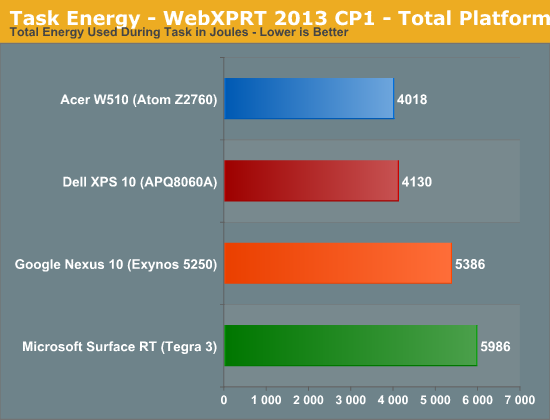
Once again, peak CPU power usage is in a completely different league. Here we see spikes nearing 4W for the dual core Cortex A15 SoC, compared to < 1.5W for Intel and Qualcomm.
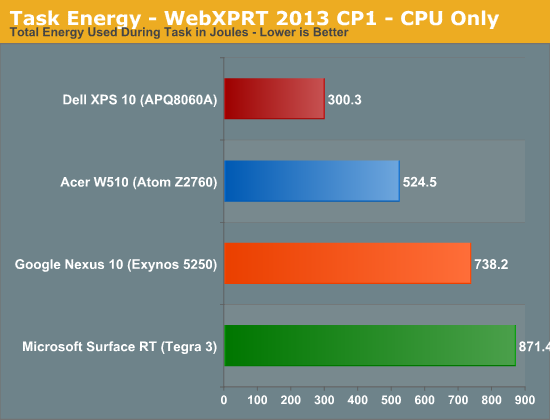
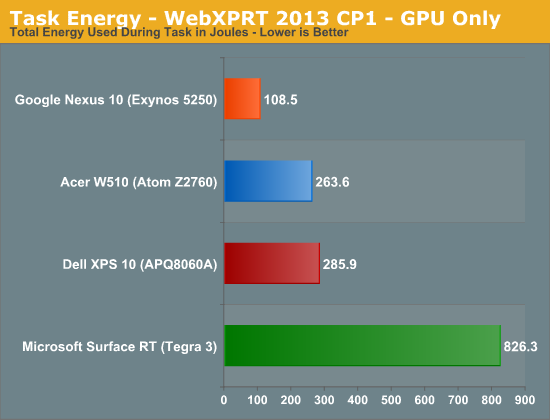
WebXPRT 2013 CP1 - Max, Avg, Min Power
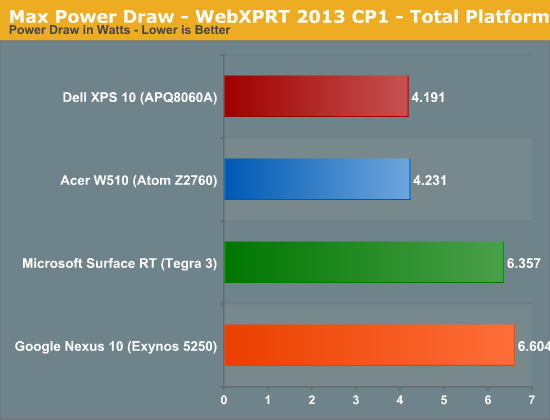
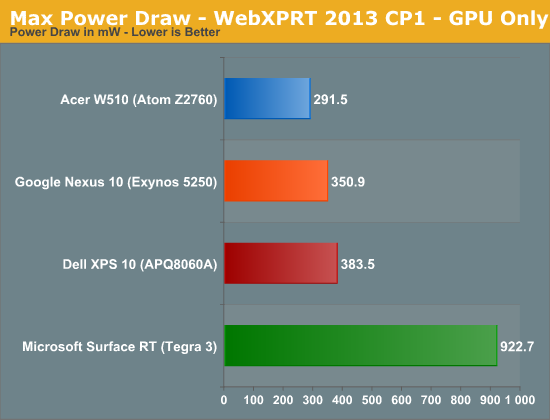
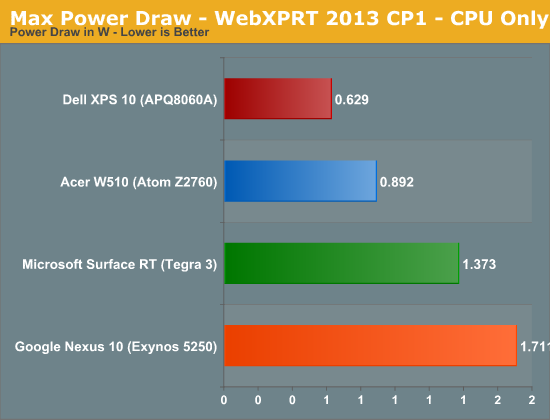
Average Power Draw
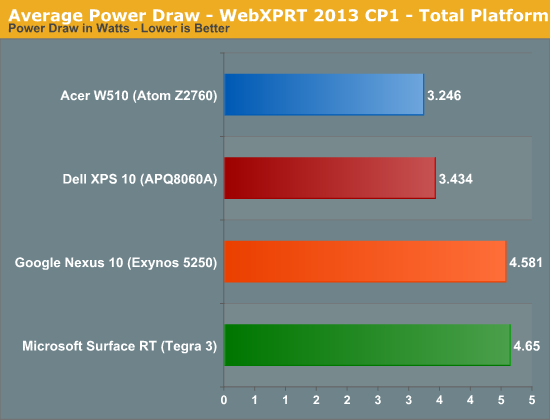
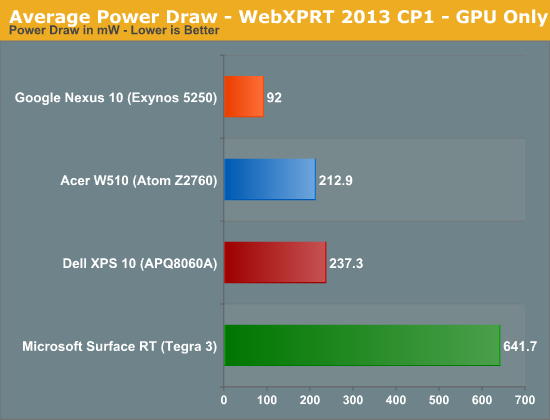
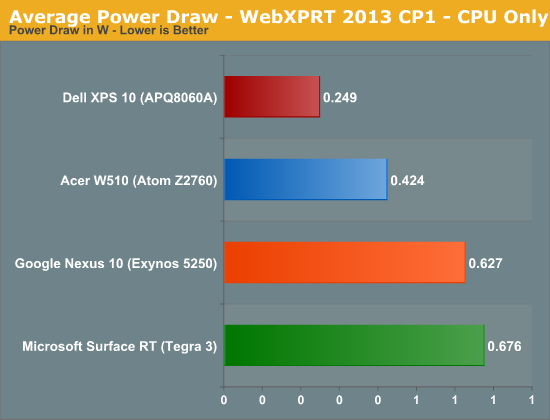
Minimum Power Draw
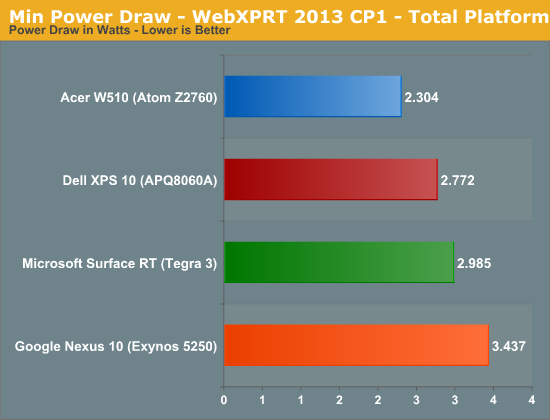
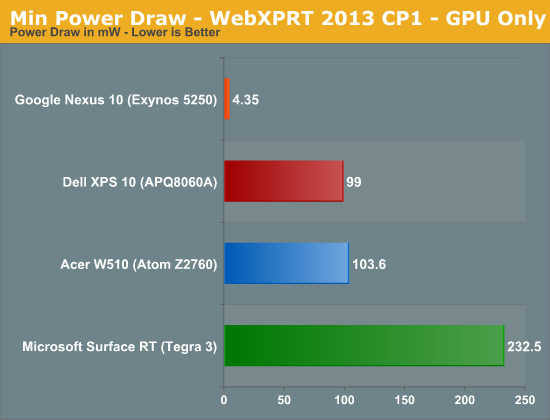





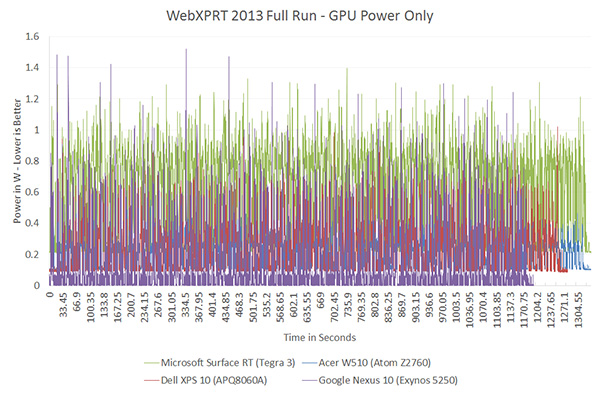








140 Comments
View All Comments
karasaj - Friday, January 4, 2013 - link
Yeah, keep in mind that Haswell will be like Windows 8 Pro, i.e. a more traditional laptop experience anyways, so it won't necessarily be strictly competing with the iPad.mrdude - Friday, January 4, 2013 - link
Win8 and its devices aren't selling, so I'm not sure how Intel plans on suddenly making that OS and the products that run on it any better. Like I said, Win8 tablet sales have been really really poor.And as far as consumers go, it is directly competing with the iPad and Android. People are more inclined to buy a new shiny tablet than a laptop and they could care less for x86 compatibility. For your average user, the iOS app store has thousands of more applications than your x86 desktop if only for the fact that it makes it incredibly easy to search through, install and play with. x86 compatibility means very little to most folks, and you can argue that it's actually a detriment due to the x86 legacy's inherent safety issues (non-Metro) and higher prices.
The "It's also a PC" shtick only works if people want PCs. Judging by the sales figures and the longer upgrade cycles, Win8's sales figures, it's clear they're obviously aren't that interested.
Krysto - Friday, January 4, 2013 - link
"One reason the Pro version of the device will be more expensive is that it uses a PC-style chip from Intel Corp. INTC -0.87% (INTC), part of a family of chips that sells for between $177 and $225. The Nvidia Corp. NVDA +3.48% (NVDA) chip typically used in the Surface RT model costs about $28, according to an estimate by research firm UBM TechInsights."http://blogs.wsj.com/digits/2013/01/04/windows-8-f...
iPhone 5's BOM is $188. iPad 3's BOM was $160. I wish Intel good luck if they think they are going to have competitive devices on the market where the chip alone costs as much as all the components in iPads and iPhones.
Oh, but that's just for IVB chips. Did I mention Haswell will be 40% more expensive - so Haswell chips will be more like $250-$300. Yeah...good luck with that Intel.
jeffkro - Saturday, January 5, 2013 - link
"I'm more than willing to pay for the performance premium."I'm not, I'm perfectly happy with the speed of my galaxy nexus which is completely outclassed by the Krait S4. So why would I want to pay a huge premium for an intel powered phone? Just give me dual core krait performance in a all day battery life phone and I'll be thrilled. For me getting more battery life takes precedence over all out speed.
djgandy - Friday, January 4, 2013 - link
True, pricing is another issue, but Intel has room to cut prices a lot. Intel makes the conscious decision to make upwards $30 on a chip rather than $3. In turn they don't have to ship as many chips.I'm pretty sure the cost of manufacturing an Atom SOC is around $5-6, so Intel has plenty of room to make money in the $20 if they so choose. There is no technical reason a Tegra 3 is cheaper than a Haswell when it comes to manufacturing. It's all about market segment.
Intel idling fabs a bit is probably due to the fact they went massive with 22nm. Intel also makes in profit a quarter 75% of what Nvidias entire yearly revenue is.
If Intel wants to play ball, I am sure they will.
mrdude - Friday, January 4, 2013 - link
But can they afford to?Those billion dollar fabs require billions of dollars to run, and if they want to maintain - or even stretch - their fab lead over their competitors, they need to make MORE money going forward. This means that if they were to compete at ARM level they can't afford to do so over a longer period of time else they'd find themselves short of cash to funnel back into the fabs and losing that distinct advantage. I remember seeing something that stood out in the latest Qualcomm earnings report, it read (paraphrasing): our fabless strategy is actually an advantage.
For Intel's fab advantage to remain an advantage they must make more and more money going forward. As soon as the sales figures look gloomy then it all goes downhill quickly, as the fabs go from being a distinct advantage to a potentially expensive disadvantage.
Intel also has investors to answer to, and this is more complicated than the microarchitecture involved. The investors expect >60% gross margins, and Intel dropped margins a bit below 60% but also let fabs idle so they wouldn't have to drop them even further. The mere fact they're latting fabs are idle means that they're not meeting sales estimates. That's not good. This is rather obvious and seen by the drop in chip sales over the same period last year. In order to keep that dip from looking worse (dropping margins even further), Intel just let the fabs idle. Smart short term strategy as investors don't look at that stuff, but it shows that things aren't 'all gravy.'
If Intel were to drop prices during a resurgent and strong PC market then I'd completely agree with you. They'd even be able to lose money in the SoC mobile arena and still show good numbers at their earnings call. That's just not the case, with PC sales slowing quite a bit and tablet sales picking up substantially, you'd have to question whether they can "weather the storm" by leaning on their dominant x86 PC/server position long enough to make up for the lower-than-usual prices in the mobile SoC space. If Intel went at ARM head on with competitive prices a couple of years ago there would be no question that Intel would remain competitive, but with weak PC sales that are expected to look even weaker compared to mobile this year?
If Intel is to compete with ARM on price, it's, oddly enough, going to be determined by how well their high profit products sell in the near future.
Ananke - Friday, January 4, 2013 - link
They can't compete on pricing with x86 vs ARM. I'm in the business, I know. Intel has absolutely competitive process facilities. If they were strictly making chips, nobody can beat them. If they license the design and make chips - nobody can beat them either. However, coupling the own design R&D expenses with own production, and their cost is higher. Products might be better, but cost is higher.On the marketing side, only price matters today. You may think performance is important, but in reality it defines 1% of the decision of 1% of the market....
Hence, the trend towards ARM designs. That trend was not accidental, it is structural, and I see no reason it will turn around.
It is the reason why AMD is performing so poorly, just Intel is much larger and owns its fabs, it takes longer to become obvious they will have revenue problems.
GillyBillyDilly - Saturday, January 5, 2013 - link
Exactly. Performance is one thing, Price another. ARM is not AMD. There is no way intel can compete with ARM price-wise. And the less competetative they are, the less they will sell and the less they sell, the less R&D and the less R&D, well, this goes on and on. I am glad I don't own any Intel shares.felixyang - Friday, January 4, 2013 - link
There is no doubt A15 is more power consuming. A A7 core can save power sometimes, but when you have a CPU intensive workload like sunspider, the A7 core's effect is limited.GillyBillyDilly - Saturday, January 5, 2013 - link
I hope you do realise that this website is a business and not a charity organisation, and no money = no business.Of course Anand is being paid for their reviews ( not only Intel related ) but as long as they don*t maipulate the data (which I don*t think they do ), their reviews are worth reading. You read it, get a general picture and make YOUR own conclusions.